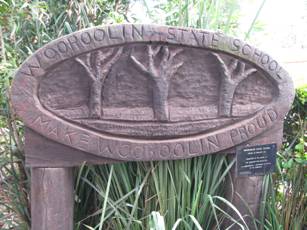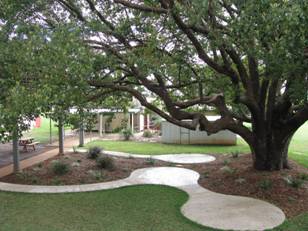 Wooroolin State School has been established for more than one hundred years. The school forms part of the vibrant township of Wooroolin and educates students from many parts of the Wooroolin district and beyond.
Wooroolin State School has been established for more than one hundred years. The school forms part of the vibrant township of Wooroolin and educates students from many parts of the Wooroolin district and beyond.
The township is situated approximately 20 kilometres north of Kingaroy and around one hour’s drive from the beautiful Bunya Mountains. The towns of Wondai, Murgon and Nanango are all within a short driving distance from our school.
Early days
In 1846, the Haly brothers, following instructions made by Governor Gibbs, named this area Wooroolin, a local aboriginal word meaning low scrub.
Forty years later, 151 square miles of Taabinga Station were resumed and land selections made around the area of Wooroolin. The country offered a mixture of solid vine scrub and forest filled with hardwood timbers of millable quality such as crowsash, yellowwood, narrow leaf iron bark and blue gum. It was, however, not until the Agricultural Homestead Selections were offered in 1898 that young families could afford to purchase land and move to the area and the tiny community around Wooroolin’s wetlands began.
Almost immediately these pioneers were discussing the need to educate their children and a public meeting was held on 13 March 1900 to begin the process of acquiring a school in their new settlement. These families had to prove that there was no school within four miles (6.5km) and that there were enough students, at least 12, to warrant sending a teacher. The Wooroolin community worked diligently to raise the necessary one-fifth of the total building costs to establish the school.
On 18 February 1901, Miss Fannie Moore opened the doors for the first students to enter classes at the Wooroolin Provisional School. There were 18 students. The school quickly outgrew its tiny building and the growing population graduated Wooroolin to a State School in 1909. A new and bigger school was established on a more suitable site in 1912. This is the site of the present school buildings.
Our school trees
In the grounds of Wooroolin State School stand magnificent old camphor laurel trees. The trees were planted on the first Arbor Day after the opening of the school. The trees are deep rooted and provide generous shade from the sun. These trees are part of the logo of Wooroolin State School and are a symbol of the meaning of the school in this community.


Former students
Quiet achievers and high profile achievers have passed through our doors.
Rear Admiral Galfry Gatacre, a past student of Wooroolin State School would proudly lead the ranks of all past students who have served in conflict around the world.
Les Birch, a student here, was one of the dam busters in WWII. He survived that operation but was almost unique in surviving the entire war as a tail gunner in the Lancaster Bombers.
Some of the finest victories in Sheffield Shield and World Cricket have seen our past student, Carl Rackemann, lead and participate. The Australian Rugby League teams have had as a member John Wittenberg who came to school here from 1947 to 1955.
G Keith D Murphy attended the Memerambi State School and went on to Scholarship at the Wooroolin State School. His parents were early settlers on the land in the South Burnett. In WWII he served with the 2nd AIF and was a Staff Captain when he returned to the Education Department in 1945. He was seconded to Head Office, where he eventually became Assistant to the Director of Secondary Education.
Kelvin
Kerkow’s education at Wooroolin began in 1974 and continued until completion of Year 7 in 1982. Although hospitalized in childhood with Guillian-Barre syndrome, Kelvin went on to win the Pine Rivers Junior Singles (later known as the Queensland Junior Singles Title) and represented Australia for over five years in his chosen sport of lawn bowls.
Present day
Our students continue to come from families both in the township of Wooroolin and beyond. Many families live on acreage or may belong to families with generational connections to the area. Most students travel to school by bus or car. Although our student population can fluctuate, our enrolment through the 1990s and 2000s has remained on average around 40. In recent times this has increased to numbers between 50 and 60. This takes account of students from the Prep (Foundation) Year to Year 6.